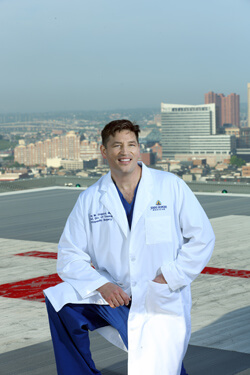
Johns Hopkins Orthopaedic Surgery
July 17, 2014
Orthopaedic surgeon Greg Osgood helps those with poorly healed trauma injuries.

Yesterday, however, Osgood consulted with a man who had fractured his arm playing sports 15 years ago and now wants surgery to restore his arm to normal length. Osgood is one of four Johns Hopkins trauma surgeons who address not only acute traumatic injuries but the aftermath for patients treated many years before.
After surgery to treat an acute injury, over time the bones may not heal correctly or may not heal at all. An infection can live at the site of surgery for years without a patient’s knowing it. The results can affect the patient’s ability to walk, work or perform daily activities because of the related pain or limited function.
These patients may consult with a number of medical professionals but get turned away because their situation seems too complex or outside the scope of a certain practitioner’s experience, says Osgood. “It’s not really trauma anymore, but it is a significant problem. Often, people don’t know who to send these patients to.”
A new approach to post-trauma surgery injuries
Osgood’s team can address nonunions and malunions from months to decades after the original injury. First, the team conducts an evaluation with X-rays, CT scans and laboratory studies to assess a patient’s situation, including whether the bone is infected. Then the options are provided and if surgery is recommended, the team can promptly begin the reconstruction process.
For the patient who suffered a fracture while playing sports 15 years ago, Osgood will combine two to three operations to perform an osteotomy to cut, realign and then regrow the bone. For another patient who was hit by a car while running three years ago, Osgood performed several operations. The patient then underwent rehab and physical therapy so he could run again.
Even though Osgood’s specialty is orthopaedic surgery, he says it doesn’t mean he will always recommend an operation. “There are things we can do without surgery and still have the injury healed,” he says. These include casting, splinting and bracing.
“Not everyone wants to tackle the problems that come from trauma,” says Osgood. “The injuries are challenging and have a higher failure rate, but I enjoy the complex problems and trying to help patients regain their function and return to their activities.”
To learn more, call 443-997-9330.

